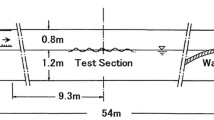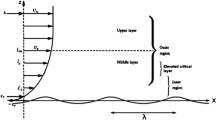Abstract
Observed critical wind speeds for the generation of wind waves are compared with those derived from a shear-flow instability theory. The theory predicts that the critical wind speed depends on the fetch and, for the case of infinite fetch, it is 93 cm s−1 at 30 cm above the mean water surface, which agrees well with observations at sufficiently large fetch. For water containing soap, the much larger critical wind speeds which are observed cannot be explained by the reduction of surface tension alone. A qualitative discussion suggests that the elasticity of surface films of soap can effectively increase the critical wind speed.
Similar content being viewed by others
References
Gaster, M. (1962): A note on the relation between temporally-increasing and spatially-increasing disturbances in hydrodynamic stability. J. Fluid Mech.,14, 222–224.
Jeffreys, H. (1924): On the formation of water waves by wind. Proc. Roy. Soc. London, Ser. A,107, 189–206.
Kawai, S. (1979): Generation of initial wavelets by instability of a coupled shear flow and their evolution to wind waves. J. Fluid Mech.,93, 661–703.
Keulegan, G.H. (1951): Wind tides in small closed channels. J. Res. Nat. Bur. Stand.,46, 358–381.
Kunishi, H. (1957): Studies on wind waves with use of wind flume (I)—On the shearing flow in the surface boundary layer caused by wind stress. Ann. Disas. Prev. Res. Inst., Kyoto Univ.,1, 119–127 (in Japanese with English abstract).
Kunishi, H. (1963): An experimental study on the generation and growth of wind waves. Disas. Prev. Res. Inst., Kyoto Univ., Bull., No. 61, 41 pp.
Lamb, H. (1932): Hydrodynamics. 6th ed. Cambridge Univ. Press, Cambridge, U. K., 738 pp.
Miles, J.W. (1957): On the velocity profile for turbulent flow near a smooth wall. J. Aero. Sci.,24, 704.
Miles, J.W. (1962): On the generation of surface waves by shear flows. Part 4. J. Fluid Mech.,13, 433–448.
Miles, J.W. (1967): Surface-wave damping in closed basins. Proc. Roy. Soc. London, Ser. A,297, 459–475.
Reynolds, O. (1880): On the effect of oil on destroying waves on the surface of water. Pap. Br. Assoc. Rept.,1, 409.
Roll, H.U. (1951): Neue Messungen zur Entstehung von Wasserwellen durch Wind. Ann. Met.,4, 269–286.
Takematsu, M. (1978): On the instability of air flow over a water surface. Rep. Res. Inst. Appl. Mech., Kyushu Univ.,25, 167–182.
Valenzuela, G.R. (1976): The growth of gravity-capillary waves in a coupled shear flow. J. Fluid Mech.,79, 229–250.
Van Dorn, W.G. (1953): Wind stress on an artificial pond. J. Mar. Res.,12, 249–276.
Author information
Authors and Affiliations
Rights and permissions
About this article
Cite this article
Kawai, S. Discussion on the critical wind speed for wind-wave generation on the basis of shear-flow instability theory. Journal of the Oceanographical Society of Japan 35, 179–186 (1979). https://doi.org/10.1007/BF02108637
Received:
Revised:
Accepted:
Issue Date:
DOI: https://doi.org/10.1007/BF02108637




